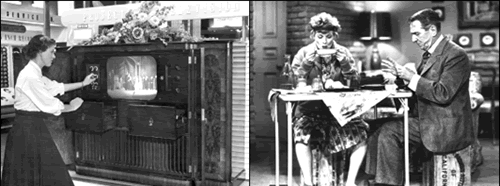1. Origin
The invention of television was a lengthy, collaborative process. An early milestone was the successful transmission of an image in 1884 by German inventor Paul Nipkow. His mechanical system, known as the rotating or Nipkow disk, was further developed by Charles Francis Jenkins, who made a telecast of a short film to U.S. government officials in Washington , D.C. , in 1925, and by Scottish scientist John Logie Baird, who broadcast a televised image in 1926 to an audience at the Royal Academy of Science in London . In 1928 Herbert Ives, an engineer working for AT&T, offered what was perhaps the most spectacular demonstration of mechanical television to that point, transmitting color images of a bouquet of roses and an American flag to two audiences simultaneously in New York City and Washington, D.C. However, the proven capability of the electronic tube system that had been developed for radio turned financial and scientific attention toward that technology and away from research on the rotating disk.
The earliest U.S. patent for an all-electronic television system was granted in 1927 to a young Philo T. Farnsworth, who transmitted a picture of a U.S. dollar sign using his so-called image dissector tube in the laboratories of the Philadelphia Storage Battery Company (Philco). Meanwhile, the three radio technology powerhouses—General Electric, Westinghouse, and RCA—were cooperating closely with each other. General Electric and Westinghouse owned substantial shares of RCA stock, and the companies shared a collection of radio patents valuable to the development of television. In 1930 they consolidated their television research efforts at an RCA facility in New Jersey under the direction of Russian immigrant scientist Vladimir Zworykin. Historians usually credit Farnsworth, Zworykin, or both with the invention of television.
2. Early Broadcasts
During the 1930s several companies around the world actively prepared to introduce television to the public. As early as 1935, the BBC initiated experimental television broadcasts in London for several hours each day. That same year, CBS hired American theater, film, and radio critic Gilbert Seldes as a consultant on its television-programming development project. RCA unveiled television to the American public in grand style at the 1939 New York World's Fair, with live coverage of the fair's opening ceremonies. This included a speech by President Roosevelt—the first televised appearance of an American president.
Daily telecasts were made from the RCA pavilion at the fair. Visitors were invited to experience television viewing and were given the opportunity to walk in front of television cameras and see themselves on monitors.
With the American entry into World War II at the end of 1941, television experimentation in the United States was virtually suspended, although radar research would contribute several advances to the field. As a measure of the importance that broadcasting technology had achieved, NBC's David Sarnoff received a commission from the U.S. Army to supervise its field communications and was promoted to the rank of general.
3. Post-World War II Popularity
Technically, network broadcasting takes place when local stations of different regions simultaneously transmit the same signal. Four companies stood ready to initiate network television broadcasting in the United States immediately following the end of World War II in 1945. Two of the companies, NBC and CBS, had made vast fortunes from radio broadcasting and were well prepared to dominate the television industry. The remaining two, the American Broadcasting Company (now ABC, Inc.) and the DuMont Television Network, were competing without the advantage of such previous commercial success. ABC had been created in 1943 when the government won a lawsuit forcing RCA to sell off one of its two national radio networks. RCA's Blue Network had been sold to Edward J. Noble, owner of the Lifesavers Candy Company, who renamed it the American Broadcasting Company. ABC managed to survive the early years of television through a corporate merger and imaginative programming innovations, many of them instituted by Leonard Goldenson, who joined Sarnoff and Paley as the third great founding mogul of American television. But ABC remained a poor third place in the programming ratings (estimates of the percentage of television viewers tuned to a particular program) for decades; it would finally catch up to its rivals in the late 1970s. The DuMont Network, owned by American television manufacturer Allen B. DuMont, was the only television network launched by a company without prior broadcasting experience. It went out of business in 1955.
Other companies unveiled plans to enter the television-broadcasting field during the early years, but they were effectively blocked by governmental regulatory decisions pushed for by the broadcasting giants. In 1948, for example, the Federal Communications Commission (FCC), the U.S. government agency that regulates broadcasting, instituted a four-year moratorium on the issuance of new TV station licenses. This freeze kept newcomers out of the broadcasting business while the radio companies solidified their hold on television. In addition, the FCC initially made only the 12 very high frequency (VHF) channels available for broadcasting, prohibiting use of the 69 ultra high frequency (UHF) channels. This action created an artificial scarcity of frequencies, preventing interested companies from operating television stations or networks. UHF licenses were eventually granted, but it was not until 1964 that all sets sold in the United States were required to have UHF as well as VHF tuners.
 By the mid-1950s the so-called Big Three radio broadcasting networks (NBC, CBS, and ABC) had successfully secured American network television as their exclusive domain. It was not until the mid-1980s that a fourth company, News Corporation, Limited, owned by Australian-born executive Rupert Murdoch, broke this oligopoly with the establishment of the Fox television network (see Fox Broadcasting Company).
By the mid-1950s the so-called Big Three radio broadcasting networks (NBC, CBS, and ABC) had successfully secured American network television as their exclusive domain. It was not until the mid-1980s that a fourth company, News Corporation, Limited, owned by Australian-born executive Rupert Murdoch, broke this oligopoly with the establishment of the Fox television network (see Fox Broadcasting Company).
In the 1990s Paramount Pictures (today a division of Viacom, Inc.) established UPN, and Warner Bros. (now a division of Time Warner Inc.) established WB, bringing the number of American commercial television networks to six.
The large-scale introduction of cable television (in which television signals are transmitted to paying subscribers by means of coaxial cable) decisively ended channel scarcity in the 1980s. Previously, viewing choices had been limited in most parts of the United States to the programming that CBS, NBC, and ABC developed or bought. The only alternatives to the Big Three were found solely in the largest cities: commercial independent stations that had no network affiliations, and noncommercial stations (known until the 1970s as educational stations, today called public stations). The independents offered mostly reruns (shows previously broadcast by a network) and a selection of older films and local sports events. In the beginning, the few existing noncommercial stations were poorly funded, airing mostly programs meant for schoolroom use in the daytime hours and a variety of documentaries, talk shows, and dramas in abbreviated prime-time schedules. These stations shared programming through a loose association known as National Educational Television (NET). Lacking network linkage technology, they typically shared programming by passing tapes from one station to another, a process known as bicycling. These stations would only begin to offer a solid alternative to commercial viewing some years after passage of the Public Broadcasting Act of 1967, which brought reliable federal funding to NET stations and resulted in the creation of the Public Broadcasting Service (PBS).

Due to lack of competition, during the first 30 years of American television the Big Three's collective share of viewership during the prime-time hours (8 pm to 11 pm, or 7 pm to 10 pm in some locations) was typically 95 percent or more. By the early 1960s more than 600 television stations, 541 of them commercial, were on the air, collectively broadcasting to about 90 percent of all homes in the United States . By the beginning of the 21st century, these numbers had increased to more than 1,200 commercial and about 370 public stations, and broadcasts were reaching more than 98 percent of homes in the United States .
Microsoft Encarta Reference Library 2005. 1993-2004 Microsoft Corporation.